Searching sustainable coexistence on the coast
Senegal, April 2013. Travelling from the capital Dakar via Kayar to Saint Louis in the north a visitor gets a flavour of the demands for space and resources on the coast and the difficulties accommodating more and more people. Google Earth images help contextualise some photos illustrating ground realities.
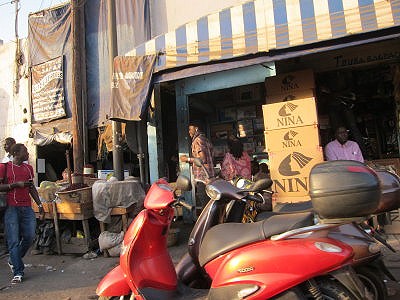
Dakar does not escape the often chaotic urbanisation trends in other major coastal cities elsewhere. The swelling of the population is driven by local demography and the attraction on people finding it difficult to make ends meet in rural areas. So the last official population estimate of just over 1 million inhabitants of Dakar in 2005 is likely to be surpassed today by quite some margin. Already at that time, the population of the Metropolitan area on the Cape Verde peninsula was estimated at almost 2.5 million. Since the administrative reform of 1996 it is divided into 19 communes d'arrondissement to make it manageable.
Gone are the days when the original Lebou settlements, such as Yoff and Hann, were geographically separated from the central plateau of Dakar. By now they are all part of an almost uniterrupted Metropolitan area that has to provide shelter, food, water, energy and transport to the permanent inhabitants, their visitors and the countless businesses and services catering for a wide range of economic, social and recreational needs.

Today, street markets have not only taken over around the building of the historical Sandaga and Kermel markets on the Plateau of the Cape Verde peninsula, the historical and current political and administrative centre. Mobile vendors are now encroaching streets and street corners around the expanding city in an ever moving dynamic to respond to shifting demands.
It bespeaks the organisational skills, energy and ingenuity that the logistics get accomplished day after day.
Well, sometimes they don't. And the achievements come at a cost. They can be seen every day in snaking traffic. You learn that largely untreated urban sewage and industrial wastewaters being discharged into the sea. You smell the air pollution. You see narrow footpath and doors and you imagine cramped housing conditions.
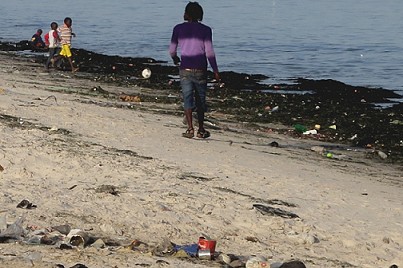
If you can compare with 20 or more years ago, you note an increase in litter and waste in the streets and the once beautiful beaches. The litter can depress you and lower your own threshold for proper behaviour. It often comes together with poor maintenance of streets and buildings. It does not have to be like this, because inside the houses great care is taken for cleanliness. But public spaces have lost a lot of their attractiveness to ubiquitous plastic bags and all kinds of other litter.
It is also difficult for public services to meet demand for schooling and education, health, energy supply and communication for a population that has doubled in a rather short timespan.
Ties in extended families and the neighbourhood remain strong and a source of mutual support.
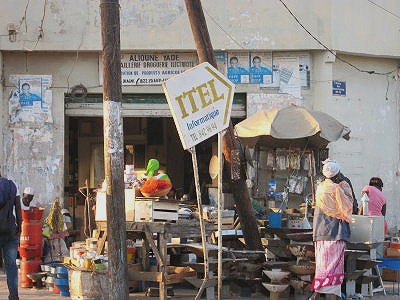
The expansion of port activities and their changing nature towards more container traffic, ship maintenance and repair as well as a hot spot for hydrocarbon traffic is another major development, which does not remain without effect on the economic structure of the countries and the people on the coast. We did not specifically look into the petroleum and gaz economy and its multiple effects, but the major environmental effects are being summarised in the IUCN Knowledge Handbook about marine and coastal environments in West Africa.
The handbook also provides a neat introduction into the natural dynamics on the coast, the balance between erosion and accretion and how these are affected by the currents and the existence or absence of rivers, which transport material into the sea. Erosion is often accentuated, when rivers get dammed as the material from the land is missing and the tides and currents may then dent the coastline in a stronger way.
A quite spectacular example is the re-appearance of ancient man-made structures on the seafloor as the Nile delta in Egypt recedes following the construction of the Assuan High Dam.
From Dakar to Kayar
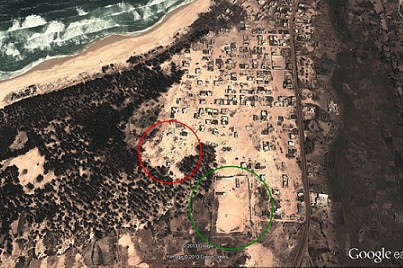
Yet the challenges for living sustainably in the coastal space and within renewable resources look set to require a lot of fresh thinking on how to accommodate often competing demands for space and resources.
Taking the situation in Kayar - the green circle on the Google map shows the location of the mid-level school (CEM) at the outskirts of town. The red circle marks the most recent encroachment of urbanisation that goes hand in hand with mostly illegal sand extraction.
This is gradually killing off the coastal forest, which stabilises the dunes and rich freshwater supplies. Kayar's location allowed it to draw on the natural wealth of the sea and, thanks to the freshwater, produce high value vegetables for nearby markets.
phocamaps view=map|id=1}

Vegetable growing - and thus land ownership and use - is regaining importance in response to the decline in the fishery, though it remains a major pillar of the local economy. WWF supported local efforts are also underway to help rebuild the degraded resource base through enforcement of a marine protected area. Abdoulaye Diop, national president of the Collective of Senegalese Artisanal Fishermen (CNPS) and based in Kayar, fully endorses and supports the efforts.
In many ways the town has prospered during the boom years of the fisheries as can be seen by the construction activities. It is 'catching up' as it becomes better connected to the rest of the country. That is a challenge to prevailing traditional Lebou culture and raises new questions about how to deal with changing expectations of youth when living conditions change.
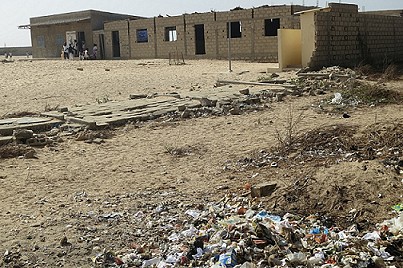
Kayar's sons who survived the treacherous emigration routes into Europe help economically with remittances to the lucky families and with new ideas, but others feel left behind.
How to acquire new knowledge and skills that are necessary in order to cope successfully with all the on-going change and be fit for the future? How to reign in the open transgressions of existing laws and regulations for the benefit of all town dwellers not only a select few?
The perceptions about the usefulness of formal schooling are shifting as a result. But the four primary schools can hardly cope with the large numbers of kids - up to 120 per class. Unsurprisingly, many kids don't make it to the end of primary schools despite the best efforts of the teachers. For those who do, Kayar offers only on mid level school (CEM) for further study. The CEM is seriously undersupplied with class rooms and all sorts of basic equipment. Furniture for the kids and teachers is incomplete and the lab equipment for more hands-on teaching of natural sciences is still a dream of the principal. Funds for investment in completing the basic infrastructure, including roofs and protective wall are desperately short. The school directors and teachers have their own take on the unsatisfactory conditions for all members of the school community and develop initiatves as best they can to bring about improvements. Abibou Diop, principal of the CEM has been lobbying relentlessly for improvements, with some success. But a lot still needs doing. It takes great strength to keep going despite the huge difficulties and they deserve recognition and support for that. Some highlights can be seen here.
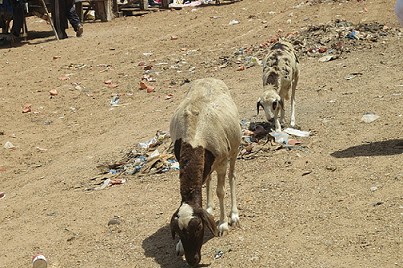
Garbage collection and treatment is another sour area. The unregulated dumps just outside the CEM and in the forest convey a sense of disregard for the town and reduce environmental quality. Much of the plastic will end up in the sea and contribute to the now global crisis of marine litter.
With goats roaming freely, it is unavoidable that they will ingest some of the plastic and other garbage, which may be unhealthy for themselves and the humans feasting on them at a later stage. The goats also contribute to spreading the garbage further.
At least in the occasion of World Environment Day, 5 May, the CEM and possibly other schools will engage again in a fantastic beach cleaning operation. Last year's was very successful.

What about having world environment day every day of the year to make Kayar a most beautiful and colourful town?
One might even take care of the waste water that spoils part of the landing area.
Of course, organising such general services and maintaining them supposes that inhabitants themselves are not willing to put up such surroundings. It would mean changing some working habits and also finding ways to pay for such services.
Would the need for meeting sanitary standards for exported seafood and diversified economic activities create incentives to address the waste problem before it becomes a serious public health issue? Will the proud inhabitants of Kayar and their leaders find an effective solution soon?
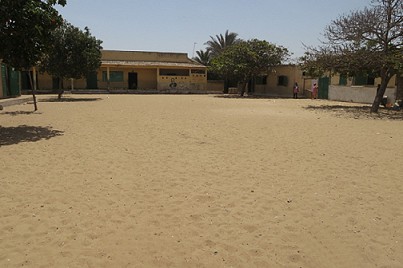
At the primary school Kayar 1 the director and the teachers take special care that the kids collect and separate garbage each day within the school yard and the classes to keep their learning environment clean.
It's a daily struggle because even if nobody at school would drop paper or garbage, the wind may swirl garbage around and collect it in corners. The daily effort pays off as the orderly facilities radiate a pleasant atmosphere.
The kids seemed to learn the lesson. We saw the result in the form of different sacks of garbage piled up in a wind-protected corner. One can only hope that final disposal is well ensured so as to ensure a positive learning outcome with a lasting commitment beyond the confines of the school area.

Visiting all classes one after another with Director Adama Ndiaye (see photo on the right), we also noted that the kids happily and competently answered questions asked by the director despite overcrowded class rooms.
Will they be the future leaders and innovators? There is no reason to doubt that.
Hitting the road again in direction of Saint Louis, we remain in thought about the different strategies to improve their lot we have criss-crossed in the different encounters: from seeking short-term advantages with little knowledge and concern for wider repercussions, when we caught a glimpse of urban encroachment and its early consequences to the longer-term investment in the kids to be better prepared for the future.
Saint Louis, Guet Ndar and the shifting ground in the Senegal River delta

On the road, we saw many signs of the contrasting developments, new constructions and wealth generation on one side and utter delapidation and plastic pollution on the other.
Making it finally to Saint Louis, we caught first glances of its old colonial island town, the successful fisheries managed out of the overcrowded conditions in Guet Ndar and seemed to hear the sounds of the famous jazz festival that attracts aficionados from all over the place to Saint Louis in May every year.
The beauty of modern travel is that one can get a first visual impression 'from above' even before getting anywhere. It helps making sense of the more visceral experience on the ground.
The Google Earth image shows the colonial part of Saint Louis perched on the island connected by a bridge to the Langue de Barbarie in the lower left part of the image and the Faidherb Bridge connecting it to modern-day Saint Louis above, all set in the ever moving land- and seascape of the Senegal River Delta.
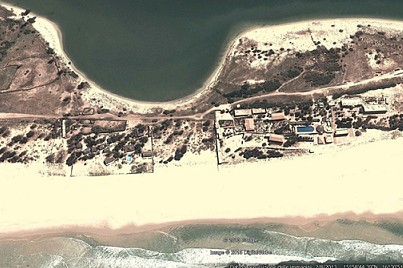
Much of the Langue de Barbarie is densely populated, particularly the part occupied by the crowded Guet Ndar fishing community opposite the island of Saint Louis.
The remaining space is constituted by a vast cemetry, a so-called hydrobase, sprawling hotel constructions shown in greater resolution in the image to the right and a protected area at the tip of the peninsula.
phocamaps view=map|id=2}
The fishery of Guet Ndar is probably the biggest in the country and not confined to this location. The fishermen there have a long-standing reputation as recalled by Malick Gueye, one of their historical leaders and at 92 years still an imman concerned about peaceful coexistence between the religions and communities and concerned about reigning in excessive and destructive fishing practices.
Malick himself, with a few fellow fishermen from the community, was sent by the government after independence as development assistant to Benin, in the Gulf of Guinea, to teach the local fishers. The interview with the story of his extra-ordinary life is available here.

The fishing crews of Guet Ndar have signed up in the past with industrial boat owners to be taken as far south as Guinea with their boats loaded on a mothership. Several crews also regularly operate out of Nouadhibou in Mauritania to service the European market more directly through Las Palmas. Much of the seasonal sardinella caught in the encircling nets and landed on the beach opposite the Saint Louis island goes nowadays in refrigerated trucks straight into Mali. What can be processed locally is handled by the women of Guet Ndar. They work in very difficult sanitary and space conditions on the beach.
As municipal adviser in Saint Louis, Awa Seye, represents the interests of her community in the council and vis-à-vis the administration. On the top of her agenda are three concerns:
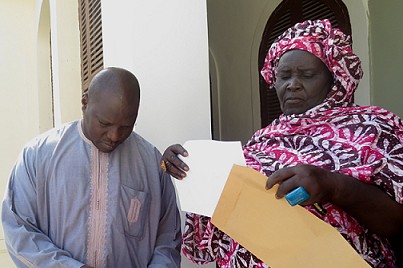
Concern number one is without doubt the issue of safety at sea right now. Some two dozen men lost at sea in the first months of 2013 is a heavy death toll affecting many of the families in Guet Ndar. The administration opened the narrowest part of the lower part of the Langue de Barbarie in October 2012 to prevent heavy flooding in town. Unexpectedly, instead of closing the new gap quickly through the prevailing current and sand transport the opening widened to perhaps 200 meters now and changed the flows and position of sandbanks. Even with safety equipment such as gps and life vests several accidents cost the lives of fishing crews.
It's a much debated problem, but somehow the port authority, security forces, several other public services, the university researchers, NGOs and fishermen seem not yet have come together in one place in the common search of viable answers to these deadly dangers.
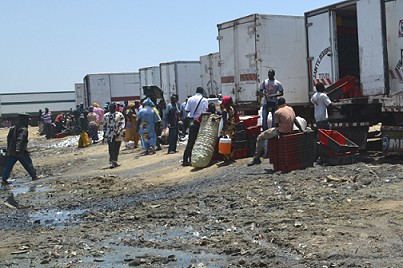
Concern number two is the problem of maternal and infant health and public health. Suffering herself several still births, Awa had the chance to be trained as a midwife in her earlier years. She took it with both hands and has since delivered many babies, initially even in her own room. She is still working on how to improve health services in Guet Ndar and encourages systematic schooling of kids, particularly girls. She wants them be better prepared and able to make better informed choices. Some 22 girls are named after her in recognition of her role as midwife and for outstanding community service.
Concern number three is to ensure sufficient and decent working space for the women fish processors and vendors. It comes down to a whole host of issues. The first is to get a bigger say in the way the very limited space on Langue de Barbarie is allocated and managed. The women affirm their right to adequate space to develop their business. They are not happy with how the positioning of refrigerated trucks is managed in partial disregard of existing rules. The biggest thorn in the side of the women are, however, the land claims of the tourist operators.
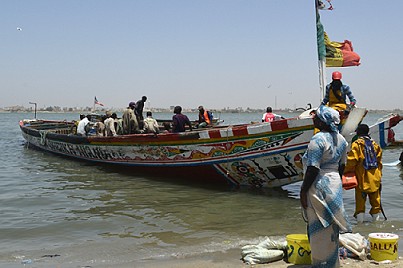
Not unlike developments in other parts of Senegal and other countries, there is growing competition between traditional fisheries, infrastructure development and a form of tourism that is in the hands of outside investors and which leaves no benefits in the community. On the contrary, as only too often happens, the tourists need their own security, food and stereotyped vistas and leave behind their trash. They may take folkloristic pictures from their four-wheel cars of the colourful boats and the bustling life on the beach in Guet Ndar, but the'd rather not stop to buy anything in the community.
It's a tricky issue. More than one fishing community has hoped that tourism might bring alternative sources of income when they faced the low end of the boom and bust cycle. But unless they were able to muster the skills and capacities to run at least part of the business themselves this has often not materialised. When traditional fishing communities did not have the political clout to influence the frame conditions of desired diversifications, they have lost out to outside investors with deeper pockets. These considerations are also on Awa's mind when she casts around for securing a more important say for the Guet Ndar community in the public and private discussions affecting safety at sea and all the other vital concerns of her people.
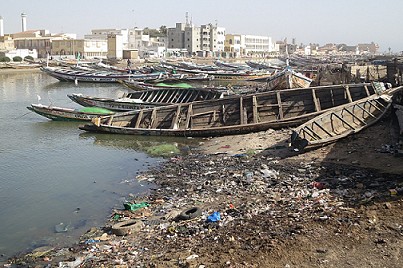
Meanwhile the community have their own set of challenges, which do not depend exclusively on cooperation with others. Keeping the working spaces on the beach clean is one such challenge as a view from the bridge leading towards Guet Ndar shows.
Becoming more actively engaged in shunning the use of prohibited monofilament nets. You can see them about openly. So, there seems to be little sense of wrong and even less enforcement of this sort of rules. It's an illustration that the community is not homogeneous and issues get prioritised differently by different families or at different times depending on the shifting ground of how interests are perceived.
Sadly, also the small, nominally protected area at the remaining tip of Langue de Barbarie seems not to be immune - neither from being littered from one side to the other nor from extractive activities. During the visit with Awa, we found a crew happily operating nylon nets from a boat inside the protected area and also saw individual fishers working from the shore.
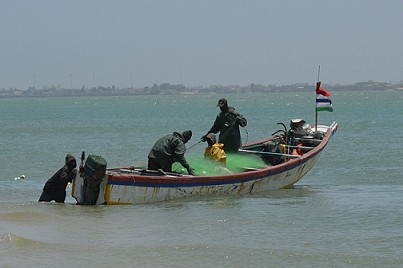
In the face of harsh survival conditions both authorities and fellow fishermen tend to turn a blind eye on individuals ignoring the rules. This is not confined to Senegal. It might, however, be worth explaining that protected areas - when respected - demonstrably serve as an insurance policy against the ups and downs of nature and the fishery itself. Moreover, the strategy of migration on a seasonal basis into neighbouring countries or areas, which helped to cope low local resource abundance is becoming more problematic as extraction is now heavy in most places and is leading to a general trend of resource depletion. In the past, migration was a rational response to deal with the bust of the cycle or simply respond to the uncertainty and natural resource fluctuations. Needless to say, that depletion tends to amplify the fluctuations, while healthy ecosystems are usually much more robust and stable. So migration might become more of a double-sided sword, not to mention the effects on the fisherfolk in host countries and regions.
In a short time we got some initial impressions about the multi-facetted challenges of organising sustainable ways of living on the coast and with its renewable resources. The short tour raised more questions than we could possible answer. One thing seems certain, the need for broader-based dialogue.
We echo Awa Seye's suggestion to create a dialogue space giving all parties concerned a voice, but also helping to take care that existing rules get better enforced. She thinks that this would help a lot in reducing mistrust between the authorities and the fishing communities in Saint Louis and elsewhere. She is also convinced of the need to engage more strongly in public debate and participation. It would allow for a greater role in shaping the future of this vital economy and culture of the city of Saint Louis and the entire country.
Text by Cornelia E Nauen, Photos by Paolo Bottoni.








